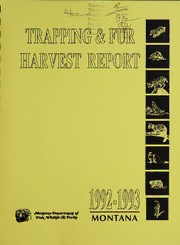
Trapping & fur harvest report PDF
Preview Trapping & fur harvest report
dMoijttuja DepartTqeTft o/" MONTANA •Fisfi.TtfUOge CSL TUif@ This report was compiled by the Wildlife Division, Research and Technical Services Bureau, Harvest Surveys Section Candy Haskins Bill Hoskins Statistical Technician Programmer/Analyst Terry Lonner Harvest Surveys Supervisor Digitized by the Internet Archive in 2019 with funding from Montana State Library https://archive.org/details/trappingfurharve1992mont PREFACE 1992-1993 TRAPPING AND FUR HARVEST REPORT Survey Approach A trapping and fur harvest survey questionnaire was mailed to all resident and nonresident Trapper's license holders. Questionnaires were returned from 905 (48%) of the 1,898 people who purchased a trapper's license during the 1992-1993 trapping season. Expanded estimates of furbearer trapping, hunting, and harvest activities were made from the returned sample. Definitions TRAPPERS .Total number of people who set traps for the given species TRAP DAYS .The sum, for all traps set, of the number of days each trap was set CATCH .Total number of animals of given species caught by all trappers TR DAYS / CATCH.Trap days per animal caught, defined as total trap days divided by total catch TRAP OR HUNTERS .Total number of people who participated in trapping and/or hunting and/or houndsman activity TOTAL HARVEST .Total number of animals of a given species taken by trapping and hunting and houndsman activities MEAN HARVEST .Total harvest divided by number of trap or hunters SPECIES % COMP.An abbreviation for species percent composition which is defined as catch for individual species divided by total catch for all species and multiplied by 100 Explanations Several changes were made in the trapping and fur harvest survey, analysis, and report for 1992-1993. One major change was that data were collected by county and estimates were reported by county and fur trapping district. In reports for the trapping seasons 1989-1990 through 1991-1992, Deer, elk, bear, and lion hunting districts were used and estimates were reported by administrative region. Reports previous to 1989-1990 used trapping districts which have been discontinued. The second major change was the addition of six species of furbearers to the survey and report. The six species added were marten, fisher, wolverine, bobcat, lynx, and otter. These six species require harvest registration forms. The registration forms have been the primary source of information for these species in the past. The inclusion of these species in the survey will give additional infor¬ mation on effort. Harvest estimates for the six "registered" species will not always agree exactly with the numbers registered, because this report gives estimates made from a sample of all trappers. (CONTINUED) PREFACE (CONTINUED) Another major change in the survey and report was the addition of hunting and houndsman activities and harvest. The relative precision of the estimate increases with the size of the estimate. Trapping district estimates have greater relative precision than county estimates and the statewide estimates have the greatest relative precision. Questionnaire response data with missing or invalid county information was still used in the analysis and is reported as "DIST. UNKNOWN" Total Catch W •;: w o 5 o O O O o O o O O O o o C o J o8 w8 o8 o ow3 ow3 oW3 o8 ow8 Oo 8 HOo ; oO £V ? r- O T- O £ Si /m* 8 CO 1C_B 8 £ 8 is 8 0 5 3 mIIIII 0 mmm 0 0 6 - 1 Mipiij __ *1111 II lilis, _ i **■11: ■1 tilllf i - 0 5 SP1| 3 IW t-mm lll|v S® P -''^llllllll \w .•.■■• ®8« 0 ^Jji m 0 1* 0 m ^mmm 6 'v ' v:< - r 8 S Up HI' 8 CO 1co_ '\- s ‘ 8 £ 3 CO i 3 - 0 5 3
